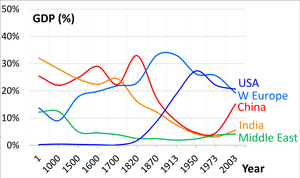
Back تاريخ الهند الاقتصادي Arabic تاریخ اقتصاد هند FA भारत का आर्थिक इतिहास HI Հնդկաստանի տնտեսական պատմություն HY ഇന്ത്യയുടെ സാമ്പത്തിക ചരിത്രം Malayalam د هند د اقتصاد تاریخ PS ඉන්දියාවෙහි ආර්ථික ඉතිහාසය SI
This article's lead section may be too long. (September 2023) |


Around 500 BC, the Mahajanapadas minted punch-marked silver coins.[citation needed] The period was marked by intensive trade activity and urban development.[citation needed] By 300 BC, the Maurya Empire had united most of the Indian subcontinent except Tamilakam, which was ruled by the Three Crowned Kings.[3] The resulting political unity and military security allowed for a common economic system and enhanced trade and commerce, with increased agricultural productivity.[citation needed]
The Maurya Empire was followed by classical and early medieval kingdoms, including the Cholas, Pandyas, Cheras, Guptas, Western Gangas, Harsha, Palas, Rashtrakutas and Hoysalas. The Indian subcontinent, due to its large population, had the largest economy of any region in the world for most of the interval between the 1st and 18th centuries.[2][4][5][failed verification][6][better source needed] Angus Maddison estimates that from 1-1000 AD India constituted roughly 30% of the world's Population and GDP.[4]
India experienced per-capita GDP growth in the high medieval era, coinciding with the Delhi Sultanate.[citation needed] By the late 17th century, most of the Indian subcontinent had been reunited under the Mughal Empire, which for a time Maddison estimates became the largest economy and manufacturing power in the world, producing about a quarter of global GDP, before fragmenting and being conquered over the next century.[7] Bengal Subah, the empire's wealthiest province, had an advanced, productive agriculture, textile manufacturing and shipbuilding, in a period of proto-industrialization.[8][9]
By the 18th century, the Mysoreans had embarked on an ambitious economic development program that established the Kingdom of Mysore as a major economic power.[citation needed] Sivramkrishna analyzing agricultural surveys conducted in Mysore by Francis Buchanan in 1800–1801, arrived at estimates, using "subsistence basket", that aggregated millet income could be almost five times subsistence level.[10] The Maratha Empire also managed an effective administration and tax collection policy throughout the core areas under its control and extracted chauth from vassal states.[11]
India experienced deindustrialisation and cessation of various craft industries under British rule,[12] which along with fast economic and population growth in the Western world, resulted in India's share of the world economy declining from 24.4% in 1700 to 4.2% in 1950,[13] and its share of global industrial output declining from 25% in 1750 to 2% in 1900.[12] Due to its ancient history as a trading zone and later its colonial status, colonial India remained economically integrated with the world, with high levels of trade, investment and migration.[14]
From 1850 to 1947, India's GDP in 1990 international dollar terms grew from $125.7 billion to $213.7 billion, a 70% increase, or an average annual growth rate of 0.55%. This was a higher rate of growth than during the Mughal era (1600–1700), when it had grown by 22%, an annual growth rate of 0.20%, or the longer period of mostly Maratha Confederacy rule from 1700 to 1850 where it grew 39%, or 0.22% annually. However, by the end of British rule, India's economy represented a much smaller proportion of global GDP. In 1820, India's GDP was 16% of the global GDP. By 1870, it had fallen to 12%, and by 1947 to 4%. The Republic of India, founded in 1947, adopted central planning for most of its independent history, with extensive public ownership, regulation, red tape and trade barriers.[15][16] After the 1991 economic crisis, the central government began policy of economic liberalisation.
- ^ Maddison, Angus (20 September 2007). Contours of the World Economy 1-2030 AD: Essays in Macro-Economic History. Oxford University press. ISBN 978-0-19-164758-1. Retrieved 3 November 2024.
- ^ a b Maddison, Angus (2007). Contours of the World Economy 1–2030 AD: Essays in Macro-Economic History. Oxford University Press. p. 379. ISBN 978-0-191-64758-1.
- ^ R.S. Sharma (2005). India's Ancient Past. Oxford University Press. p. 206.
- ^ a b Maddison, Angus (2003): Development Centre Studies The World Economy Historical Statistics: Historical Statistics, OECD Publishing, ISBN 9264104143, p. 261
- ^ Paul Bairoch (1995). Economics and World History: Myths and Paradoxes. University of Chicago Press. p. 95. ISBN 978-0-226-03463-8.
- ^ "Power of Data Visualisation".
- ^ "The World Economy (GDP) : Historical Statistics by Professor Angus Maddison" (PDF). World Economy. Retrieved 21 May 2013.
- ^ József Böröcz (10 September 2009). The European Union and Global Social Change. Routledge. p. 21. ISBN 9781135255800. Retrieved 26 June 2017.
- ^ Sanjay Subrahmanyam (1998). Money and the Market in India, 1100–1700. Oxford University Press. ISBN 9780521257589.
- ^ Parthasarathi, Prasannan (2011), Why Europe Grew Rich and Asia Did Not: Global Economic Divergence, 1600–1850, Cambridge University Press, p. 45, ISBN 978-1-139-49889-0
- ^ S. A. A. Rizvi, p. 263 of A Cultural History of India (1975), edited by A. L. Basham
- ^ a b Jeffrey G. Williamson, David Clingingsmith (August 2005). "India's Deindustrialization in the 18th and 19th Centuries" (PDF). Harvard University. Retrieved 18 May 2017.
- ^ Maddison 2003, p. 261.
- ^ Baten, Jörg (2016). A History of the Global Economy. From 1500 to the Present. Cambridge University Press. p. 250. ISBN 9781107507180.
- ^ "Economic survey of India 2007: Policy Brief" (PDF). OECD. Archived from the original (PDF) on 6 June 2011.
- ^ "Industry passing through phase of transition". The Tribune. Archived from the original on 24 March 2014.